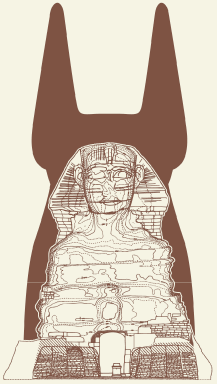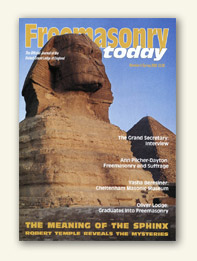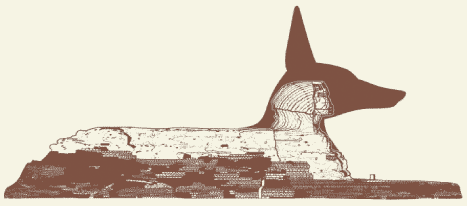

Download the British press release here PDF (812k)
‘Brilliant! A remarkable work of detailed and painstaking research, integrative thinking, and original insight. The Temples’ reinterpretation of some of Egypt’s abiding mysteries is more than thought-provoking: it is inspiring.’
- Dr. Rupert Sheldrake. Author of 'The Presence of the Past'
‘I was swept straight into this marvellous book. It’s brilliant, original, occasionally delightfully malicious, and it showed me just how little I really knew about the Sphinx.’
- Colin Wilson. Author of 'Atlantis and the Kingdom of Neanderthals' and 'The Outsider'
'The true mysteries of the Sphinx, both hidden and forgotten, are brilliantly exposed in this compelling book by Robert and Olivia Temple. They have uncovered hard data revealing the manipulation and misinterpretation that dominate this area of Egyptology. Their use of solid evidence, textual and photographic, make their case unarguable .'
- Michael Baigent. Coauthor of 'Holy Blood, Holy Grail' and author of 'The Jesus Papers'
'Robert and Olivia not only did an outstanding job of pulling together a treasure trove of little known historic facts and photos but they put them together in a way that tells an exciting and compelling story. This book clearly lays out the age-old Sphinx mystery like a puzzle, and then solves it while making sense of every anomaly along the way. What an excellent piece of work!'
- Walter Cruttenden. Director, Binary Research Institute.
 NEXUS Magazine (ApRIL-MAY 2009)
NEXUS Magazine (ApRIL-MAY 2009)In the revised edition of his best-selling book The Sirius Mystery (1998). Robert Temple gave clues to a completely different interpretation of the Great Sphinx, Here, he expands upon these amazing assertions.
Chief among them is that, contrary to long-time consensus belief, the body of the Sphinx does not portray a lion at all; it's a crouching wild dog or at least a jackal, and it represents the god Anubis (or Anpu). Anubis guarded the dead and thus had an important role on the Giza Plateau necropolis as part of a pharaonic resurrection cult. Furthermore, during the Old Kingdom, the Anubis monument was surrounded by a moat filled with water that formed what the ancient Pyramid Texts called lackal Lake. While its accepted that the disproportionately small head of the Sphinx was recarved into human form, it did not portray Cheops or Chephren but a much later pharaoh. Amenemhet II of the Twelfth Dynasty
 FREEMASONARY TODAY (Spring 2009)
FREEMASONARY TODAY (Spring 2009)To see the review in its original context click here
Some years ago Robert Temple coined the term 'consensus blindness’. He had found hundreds of ancient Optical lenses languishing in museums around the world forgotten and ignored under the label of 'religious artifact'. But they magnified. Nevertheless, because everyone knew that optical lenses did not exist two thousand years ago or more their practical quality was ignored: Consensus blindness. Temple wrote about this in his book The Crystal Sun.
Robert Temple however, knows what he is talking about; he is an expert in ancient technology and has applied his great talents for research and investigation to ancient Egypt, in particular the Sphinx. Here he reveals, consensus blindness remains alive and well. The story explained in The Sphinx Mystery is fascinating, illuminating and cannot help but raise some anger at those who have sought to cover up or even destroy solid evidence of a host of tunnels and crypts within, beneath or near to the Sphinx. Hie early explorers - whose accounts Temple reproduces together for the first time - knew about them but most have since been blocked up or covered over. Now, thanks to Robert and Olivia Temple, we know that they are there.
But tbe biggest mystery of the Sphinx for Egyptologists is the apparent lack of any mention of its existence in early texts. Temple demonstrates an alternative; it is well known that the Sphinx's head was re-carved at some time with the face of a Pharaoh, some say Khafre; Temple reveals the likely candidate to be Amenemhet II (about 1876-1842 BC). But it is obvious that the head is now out of proportion to its body; it is too small. Temple argues convincingly that the head was originally not that of a Pharaoh but of the jackal god, Anubis, the ancient Egyptian guardian of the place of the dead which, as it happens, was the Giza Plateau. Anubis appears in many very early texts including the first known, those carved on the walls of the 5lh Dynasty Pyramid of Unas at Saqqara. It seems likely that Temple is correct, in which case the Sphinx, that is, Anubis. Was, contrary to accepted wisdom, frequently mentioned.
For anyone interested in ancient Egypt this book is required reading. It is a fascinating and compelling study of how consensus blindness, adopted too often with a dogged arrogance, is the perennial enemy of research and understanding.
- Michael Baigent.
Into The Duat.
The Weblog of Into The Duat Magazine
If you only ever read one book about the Sphinx...
Robert and Olivia Temple, who I am privileged to call friends, have written a new and soon to become rather important book about the Sphinx and Giza. I will be writing a full review of The Sphinx Mystery: The Forgotten Origins of the Sanctuary of Anubis, very shortly as I am still in the middle of digesting some of the books finer points and conclusions. However, I can say with certainty that this is a classic in the making. A book born of the most incredible research and dedication to a subject matter that has all too often been treated in the most simplistic of terms.
Together Robert and Olivia take us on an incredible journey of discovery, uncovering reports and writings about this amazing monument that have never been studied before. Think you knew everything about the Sphinx already? Think again. Carrying on from theories first postulated in the groundbreaking, The Sirius Mystery, Robert and Olivia make an incredibly solid case for the Sphinx to have originally been a representation of Anubis. But thats not all. They then go on to reveal that the enigmatic face of the Sphinx, debated over by Egyptologists and researchers for many years now, is neither Khafre or Khufu, but the face of Middle Kingdom Pharaoh, Amenemhat II, who re-carved the colossal statue in his own facial image at a much later date than has been debated before.
Quite brilliant detective work and deduction has gone into the book and the photographic reproductions (most of them from the massive collection that Robert holds personally) are simply immense. A new geometrical groundplan for the Giza Plateau is also put forward, and although I would respectfully disagree with Robert on his conclusions here (having been involved with my colleague David Ritchie's astonishing geometrical work at Giza - soon to be revealed in full here), its wonderful to see such well researched ideas put forward.
This is a book not to be missed. I heartily recommend this to you all and invite comments and remarks about its subject matter at any time. I myself return to Egypt in April, with the book tucked under my arm and with my eyes further opened.
- Simon Cox (To see the article in its original context click here)
WItchgrove.com
the Sphinx Mystery
At one time, decades ago, I was attracted to the mysteries surrounding the ancient land of Egypt as are many people even today. I was even more strongly attracted by the “mysteries” written about by individuals as disparate as Sir E.A. Wallis Budge and Edgar Cayce. Throughout these writings ran the image and speculations on the subject of the Sphinx. Unfortunately most of these speculations were backed up by nothing except personal opinion. Professor (visiting professor of the history and science of philosophy at Tsinghua University in Beijing, Fellow of the Royal Astronomical Society, member of Royal Historical Society and others) Temple’s book, on the other hand, contains support for his conjectures.
Although moderately technical (there really is no way to avoid it on a subject this complex), it is eminently readable and fairly easily understood. Chapter Seven: The Sphinx and the Giza Plan is the one spot most likely to lose readers due to the complex mathematical and spatial relationships being discussed. Fortunately there are profuse illustrations throughout the book which help to illuminate the topics under discussion in the text. More photos, and some in color, will soon be available at www.sphinxmystery.info
There are no grand conspiracy theories here, although there is a certain amount of disdain for the behavior of some Egyptologists and explorers. The mainstay of the conspiracy theorists – that there is a hidden chamber proving the existence of Atlantis (or our origin among the stars, or any other pet belief) is discussed in realistic detail; as is the theory of rain erosion of the Sphinx. Both of these topics are treated as realistic topics and not dismissed out of hand.
The final 92 pages before the notes comprise Accounts of the Sphinx from Roman Times to 1817 as well as translations of various papers relating to expeditions during the 19th century as well as drawings made during an investigation of the Sphinx in 1992.
This is a thoroughly readable account of the reality of the Sphinx. There is no unfounded speculation although some deductions are made and conclusions drawn which will be at variance with both the scientific consensus and New Age beliefs. Professor Temple makes no attempt to placate either side of the debate. He simply lays out his conclusions and allows the reader to decide whether they agree or not.
-Michael Gleason
 NEW AGE RETAILER MAGAZINE (JANUARY 2009)
NEW AGE RETAILER MAGAZINE (JANUARY 2009) "There we stood, sadly looking at the Sphinx that everybody knows' is a lion, and we could see plainly that it was no such thing. We felt very lonely ..." Thus Robert Temple recounts the beginning of his journey to change many of the ideas about the Sphinx wliich have long been accepted as undeniable.
His search to understand the Sphinx and its history is recorded as an academic adventure tale. He takes us with him through long-forgotten, sometimes unpublished, writings (many of which are reprinted in Part Two), obscure photographs, and his personal observations. Because of his scientific and scholarly credentials, Temple and his wife were granted extraordinary access to the Sphinx and the temples near it. They came to think of the Sphinx as their third collaborator, and as I read the book I understood why. One comes away with a real sense of having been to Giza, of having stood before the giant creature through the ages of its existence. Temple believes the Sphinx to be Anubis, carved as a sitting dog who protects the dead. Whether or not he is able to substantiate this claim I will leave for you to decide for yourselves.
More than the unraveling of a mystery story, this book is a close-up look at the vanishing art of historical research and how academic infighting, politics, reckless restoration, and economic concerns affect such work. Temple makes an excellent case for the restoration of rigorous scholarly standards and the teaching of research techniques that go beyond electronic searches. In addition, his study of the use of the "golden angle" in the construction of the entire Giza site would make a book on its own.
Temple makes frequent reference to his previous book, 'The Crystal Sun'. His discussion of Edgar Cayce's channeled informtion regarding the Sphinx might trigger interest in writings about Cayce as well.
- Anna Jecfrziewski. Spirit Connection New York, New York, N.Y.
THE STORY BEHIND THE SPHINX - BY GEOFF WORD, WESTERN DAILY PRESS (May 2009) - Download as PDF (520kb)
www.westerndailypress.co.uk
MORE REVIEWS ON THE WEB
Read Geoff Ward's Review of our book at www.mysteriousplanet.net/books.php
